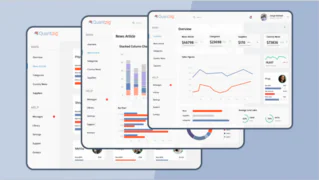The Consumer Packaged Goods (CPG) industry is undergoing a profound transformation, with a powerful fusion of convenience, digital innovation, and consumer-centric experiences leading the way. The future of CPG ecommerce and digital propositions is being shaped by cutting-edge technology, data-driven insights, and new consumer behaviors. This article delves into the futuristic trends that are reshaping the CPG landscape, where personalized recommendations, seamless shopping experiences, and sustainability are key pillars. The rise of digital natives, small-scale competitors, and established giants embracing disruption is setting the stage for a more dynamic and competitive market.
As CPG firms evolve, they must adapt to these transformative trends to stay relevant and meet the expectations of modern consumers. In this digital era, product innovation, lifecycle management, and market strategies are no longer just optional—they’re essential. The convergence of technology, data analytics, and consumer insights is empowering businesses to redefine how they interact with customers and introduce products into the marketplace. This article explores these innovative CPG ecommerce trends and digital propositions, shedding light on their importance, benefits, and the future of the industry.
Explore how our data management solutions can optimize your analytics strategy.
Request a demo
Table of Contents
What is Consumer Packaged Goods (CPG)?
Consumer Packaged Goods (CPG) refer to products that are sold quickly and at a relatively low cost, typically purchased frequently by consumers. These goods include food, beverages, personal care, household products, and other consumables that people use daily. CPG companies manufacture these items and distribute them through various channels such as supermarkets, online stores, and specialty retailers.
In the context of ecommerce, CPG refers to the online distribution and marketing of these goods. The rise of ecommerce and digital propositions in the CPG sector has revolutionized how brands connect with consumers, shifting from traditional retail models to more personalized and seamless digital experiences. This transformation is characterized by data-driven decision-making, innovative digital propositions, and the increasing demand for sustainable practices.
Importance
The importance of futuristic trends in CPG ecommerce and digital propositions lies in their ability to help businesses remain competitive and relevant in a fast-changing market. As digital platforms continue to dominate, CPG firms must leverage emerging technologies and data analytics to optimize product innovation and lifecycle management. The shift toward personalized, frictionless shopping experiences is crucial to attracting and retaining consumers in this highly competitive space.
Moreover, the integration of sustainability into digital propositions is reshaping consumer expectations, with eco-conscious purchasing decisions gaining traction. By adopting innovative digital solutions, CPG companies can tap into niche market segments, enhance customer loyalty, and gain a competitive edge in an increasingly crowded marketplace.
Advantages
- Enhanced Consumer Engagement: Through personalized experiences and tailored digital propositions, brands can deepen their connection with consumers, driving customer loyalty and increasing repeat business.
- Agility in Product Development: Real-time data and predictive analytics allow CPG firms to quickly adapt to changing consumer needs, accelerating product development and reducing time-to-market.
- Cost Efficiency: Digital solutions streamline operational processes, reducing costs in production, marketing, and distribution, ultimately improving profitability.
- Sustainability Integration: Digital propositions can integrate sustainability initiatives, helping companies reduce their environmental footprint while meeting the growing demand for eco-friendly products.
- Scalable Solutions: Ecommerce platforms and digital tools provide scalability, allowing CPG companies to grow their operations and reach new markets without significantly increasing overhead costs.
Disadvantages
- Data Overload: The vast amount of data generated through digital interactions can overwhelm companies, making it difficult to identify actionable insights and trends.
- High Initial Investment: Implementing innovative digital propositions and technologies requires significant upfront investment in infrastructure, which can be a barrier for smaller CPG firms.
- Consumer Privacy Concerns: As personalization and data collection increase, consumer privacy concerns also grow, potentially leading to distrust if data is not handled responsibly.
- Complexity in Integration: Integrating new technologies into existing systems and processes can be complex, leading to operational challenges and potential disruptions.
- Risk of Short-Lived Trends: In a rapidly changing digital landscape, what’s popular today may not be relevant tomorrow. CPG firms must be cautious of chasing fleeting trends that may not have long-term value.
Experience the impact of data-driven CPG transformation with a complimentary, no-obligation pilot tailored to your business needs. Discover real results before making any commitments.
Start your trial nowStrategies
- Embrace Data Analytics: Leverage consumer insights and market trends to inform product development and marketing strategies, ensuring alignment with customer preferences and behaviors.
- Invest in Ecommerce Platforms: Focus on building seamless and personalized online shopping experiences that cater to consumer needs and preferences, optimizing the digital journey.
- Adopt Agile Product Development: Implement agile methodologies in product innovation, enabling quick pivots based on market feedback and emerging trends.
- Sustainability as a Differentiator: Integrate sustainability into product development and marketing strategies, addressing the growing consumer demand for eco-conscious products.
- Build Consumer Trust: Prioritize transparency in data collection and use, ensuring that consumer privacy is respected and fostering long-term loyalty.
Applications
The application of futuristic and innovative trends in CPG ecommerce has gained momentum across industries, with brands recognizing the importance of adopting digital tools and strategies. For example, the rise of personalization in ecommerce platforms has allowed companies to offer more tailored product recommendations, enhancing the shopping experience and driving sales. By using predictive analytics and real-time consumer insights, CPG firms can anticipate demand and optimize inventory management, ensuring they meet customer expectations.
Furthermore, CPG companies are incorporating sustainability into their digital propositions, aligning with consumer preferences for eco-friendly products. Digital solutions like machine learning and natural language processing (NLP) are being used to analyze consumer sentiment, identify emerging trends, and optimize product offerings in line with market demands. These innovations are enabling CPG firms to stay ahead of competitors by offering more relevant, timely, and personalized products.
Finally, the growing adoption of direct-to-consumer (DTC) channels is reshaping the distribution model for CPG products. Brands are increasingly using ecommerce platforms to sell directly to consumers, bypassing traditional retail intermediaries. This shift allows for more control over pricing, product availability, and customer relationships, offering new opportunities for growth and differentiation in the marketplace.
What the Future Holds?
As we look to the future, the role of artificial intelligence and machine learning in CPG ecommerce will continue to expand. These technologies will enable even more advanced personalization, allowing brands to offer hyper-targeted recommendations and promotions. Additionally, the integration of augmented reality (AR) and virtual reality (VR) into ecommerce platforms will provide immersive shopping experiences, further enhancing consumer engagement and decision-making.
The rise of voice commerce and the continued expansion of mobile shopping are also shaping the future of CPG ecommerce. As consumers increasingly turn to voice assistants and smartphones for shopping, CPG firms will need to optimize their digital propositions for these platforms. This shift will drive further innovation in product discovery, purchase processes, and customer service, offering new ways for CPG brands to connect with consumers in the digital age.



